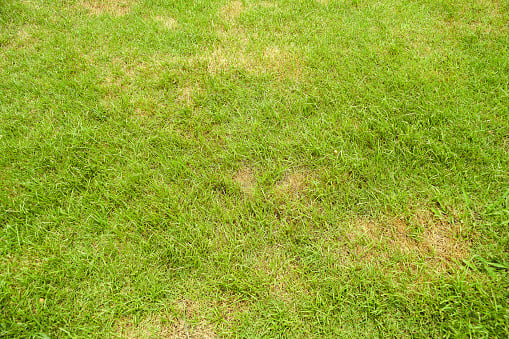Red thread is a fungal infection caused by the fungus, laetisaria fuciformis. This disease will cause irregularly shaped patches of tan or red throughout your lawn. But it really only comes down to doing one thing, to ensure you never have to worry about it.
The truth is, almost any lawn is susceptible to this turf fungus. However, it is not uncommon for some lawns to have more issues than neighboring properties. This is because of different soil conditions, maintenance, and water patterns.
So, let’s take a look at what causes red thread, the negative effects and point out the best way to control it.
What Does It Look Like?
You can identify red thread by the pinkish-red strands that extend from the leaf blade tip. Take a look at your lawn early in the morning, when it’s still moist. You might see what looks like miniature pink cotton balls.
If you take a look at your turf early in the morning when it is still moist, you might find what looks like miniature balls of pink cotton candy. That’s a tell-tale sign.
But it can be mistaken for dollar spot or lawn rust. That’s because the grass is usually tan or light brown beneath the growths. To properly identify the disease, you may need to get on your hands and knees to check it out.
What Causes Red Thread?
Red thread is a disease of turfgrass that is often associated with under-fertilized turf and one of the simplest recommendations to alleviate disease pressure is to fertilize. But it goes deeper than that.
Red thread loves Michigan summers. The days get very warm and the nights are cooler. These temperature changes often create a moist environment that fungi love, and it’s a perfect opportunity for them to invade your lawn. The red thread also favors cool-season grasses, such as Kentucky bluegrass, tall fescue, fine fescue, and perennial ryegrass.
How Harmful Is It To Your Lawn?
The good news is that red thread won’t kill your grass. The disease specifically attacks the leaves and stems of the grass plant. It will not harm the crown or root of the grass, but the areas that are infected will cause your turf to appear wilted.
It’s also not aesthetically pleasing and can make your lawn vulnerable to diseases.
How To Protect Your Lawn From Red Thread
The fungus that infects the turf lives in the thatch and soil and can be spread by dead infected plant material and by mowing and other mechanical maintenance. Be sure to clean your lawnmower after cutting your grass to decrease the chances of spreading the disease.
Fungicide applications are usually not necessary in dealing with red thread. The basic treatment for red thread is to fertilize the lawn with the proper amount of nitrogen as part of an ongoing feeding program.
A fertilizer application will often help your turf outgrow the damage and protect it from other potential diseases. But keep this in mind, some turf diseases are aggravated by excessive fertilization, so be sure to have an expert diagnose which disease your lawn is facing before fertilizing begins.
Don’t hesitate to connect with the Lush Lawn team for treatment options if you come across it on your lawn. Contact your local Lush Lawn branch to request our services.
